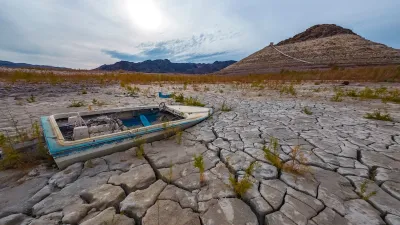Humans are a noisy lot. In addition to fouling our cities with extreme sounds and exporting our din to wilderness areas, scientists are beginning to recognize and map the substantial impact of human-generated sound on the world's waters.
For years, we've been hearing about noise pollution threatening the quality of life in our cities and the supposed silence of remote landscapes. Lest we become deaf to the full impact of our own cacophony, "the federal government is completing the first phase of what could become one of the world’s largest efforts to curb the noise pollution and return the sprawling [undersea] ecosystem to a quieter state," reports William J. Broad. Ironically, some of the most significant components of that effort are visualizations of the audible world.
"The project, by the National Oceanic and Atmospheric Administration, seeks to document human-made noises in the ocean and transform the results into the world’s first large sound maps," writes Broad. "The ocean visualizations use bright colors to symbolize the sounds radiating out through the oceanic depths, frequently over distances of hundreds of miles."
"Michael Jasny, a senior policy analyst with the Natural Resources Defense Council, a private group in New York that has sued the Navy to reduce sounds that can harm marine mammals, praised the maps as 'magnificent' and their depictions of sound pollution as 'incredibly disturbing.'”
“We’ve been blind to it,” Mr. Jasny said in an interview. “The maps are enabling scientists, regulators and the public to visualize the problem. Once you see the pictures, the serious risk that ocean noise poses to the very fabric of marine life becomes impossible to ignore.”
"Legal experts say the new findings are likely to accelerate efforts both domestically and internationally to deal with the complicated problem through laws, regulations, treaties and voluntary noise reductions."
FULL STORY: A Rising Tide of Noise Is Now Easy to See

Alabama: Trump Terminates Settlements for Black Communities Harmed By Raw Sewage
Trump deemed the landmark civil rights agreement “illegal DEI and environmental justice policy.”

Planetizen Federal Action Tracker
A weekly monitor of how Trump’s orders and actions are impacting planners and planning in America.

The 120 Year Old Tiny Home Villages That Sheltered San Francisco’s Earthquake Refugees
More than a century ago, San Francisco mobilized to house thousands of residents displaced by the 1906 earthquake. Could their strategy offer a model for the present?

In Both Crashes and Crime, Public Transportation is Far Safer than Driving
Contrary to popular assumptions, public transportation has far lower crash and crime rates than automobile travel. For safer communities, improve and encourage transit travel.

Report: Zoning Reforms Should Complement Nashville’s Ambitious Transit Plan
Without reform, restrictive zoning codes will limit the impact of the city’s planned transit expansion and could exclude some of the residents who depend on transit the most.

Judge Orders Release of Frozen IRA, IIJA Funding
The decision is a victory for environmental groups who charged that freezing funds for critical infrastructure and disaster response programs caused “real and irreparable harm” to communities.
Urban Design for Planners 1: Software Tools
This six-course series explores essential urban design concepts using open source software and equips planners with the tools they need to participate fully in the urban design process.
Planning for Universal Design
Learn the tools for implementing Universal Design in planning regulations.
Clanton & Associates, Inc.
Jessamine County Fiscal Court
Institute for Housing and Urban Development Studies (IHS)
City of Grandview
Harvard GSD Executive Education
Toledo-Lucas County Plan Commissions
Salt Lake City
NYU Wagner Graduate School of Public Service




























